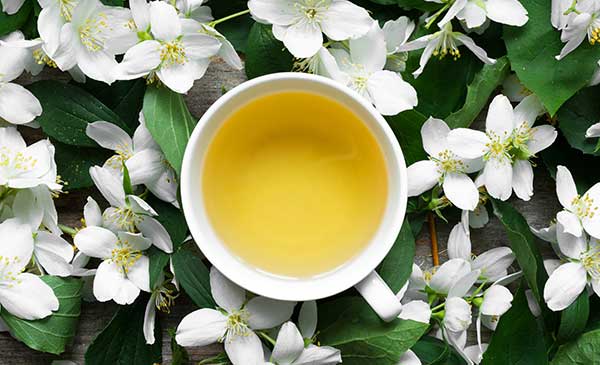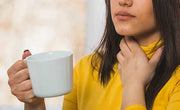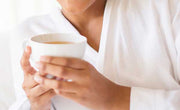Does Jasmine Tea have Caffeine?

Plus (almost) everything you need to know about Jasmine tea
When we talk about Jasmine tea, we are really talking about tea that has been blended with the jasmine blossom, either common jasmine (Jasminum officinale) or sampaguita (Jasminum sambac). The blossoms are blended with other tea to allow the aroma to infuse the leaves. The most common form is a jasmine "pearl" which is a pea-sized shape made by rolling fresh young tea leaves around a single bud.
In China, Jasmine tea is the most famous scented tea. Jasmine tea originated over a thousand years ago during the Ming dynasty in China. Later in the 19th century, the world fell in love with this relaxing sensory experience. Learn everything you need to know about the power of this delicate flower, including whether jasmine tea has caffeine.
What does Jasmine tea taste like?
There are few teas that rise to the delicacy and sophistication as a cup of jasmine tea. The scent of the jasmine flower is clearly memorable. The aroma of the jasmine bloom blended with white or green loose leaf tea has a slightly sweet and fragrant taste. These qualities make it a highly sought after scented tea.
Jasmine teas vary depending on the tea leaves used. The grade of the tea depends on the ratio of tea buds to tea leaves. Those with a large ratio of buds are considered top grade. The flavor will be more delicate and subtle when compared to a blend with larger leaves with a lower ratio of buds.
Does Jasmine tea have caffeine?
Caffeine can have a powerful effect over energy or ability to fall asleep. So one of the first questions when exploring a new tea is the amount of caffeine content in the tea. Pure jasmine tea is naturally caffeine-free.
However, the unique sensory of jasmine tea is created by blending with other tea. The delicate jasmine blossom is often blended with a delicate tea such as green or white tea. Because green tea comes from the Camellia sinensis plant and contains caffeine, the jasmine blend also contains caffeine. White tea also contains caffeine, so when blended with a white tea, jasmine tea will contain caffeine as well.
Yet, when a true tea is blended with other non-tea ingredients (such as jasmine) it reduces the caffeine level. Jasmine green tea averages 20-60 mg of caffeine depending on the amount of leaves and length of steep time.

What is Jasmine tea good for?
When blended with other tea leaves, jasmine tea provides many of the health benefits gained from the particular base tea. Jasmine tea contains plant-based compounds. These polyphenols provide antioxidant power against free radicals often linked as a cause of heart disease and cancer.
Using green tea as the base, jasmine green tea is loaded with even more polyphenols, known as catechins. The catechin EGCG has been associated with several health benefits such as:
- Providing anti-inflammatory effects
- Maintaining healthy blood sugar levels
- Boosting oral health
Is Jasmine tea green tea?
Not all Jasmine tea is green tea. If tea is made from simply the Jasmine bloom, it would be considered an herbal tea. Since Jasmine tea is typically made by blending with other teas, it takes on the characteristics of the base tea. So Jasmine tea is only considered a green tea when the blossoms have been blended with a green tea.
How is Jasmine tea made?
Jasmine tea is typically a blend with a true tea such as a delicate green or white tea. But jasmine can also be found blended with other types of tea such as oolong teas or even a bold black tea.
Jasmine tea is as delicate as the beautiful fragrant flower you see growing on the vine. The jasmine flowers bloom and are harvested during the warm months of late summer. Jasmine Green Tea Pearls are made by delicately hand-rolling young green tea leaves with one unopened night-blooming jasmine flower when the buds are at their highest scent level. This meticulous method creates an exotic night-blooming jasmine flower infusion. While steeping, the flowers unfurl for a beautiful presentation.

Jasmine Silver Needle is one of the most expensive white teas. Special grade Bai Hao leaves are gathered only during a few days in early spring. Only the single tips of the tea stem are harvested and when dried, look like silver needles.
After the tips are carefully plucked, the leaves are layered on woven trays with fresh jasmine blooms below in a warm environment. As the aroma expires, the jasmine blooms are replaced to continue creating the exotic flavor and aroma of the tea. The leaves are then gently fired to add a subtle nutty flavor. This process creates a sweetly delicate honeysuckle aroma with a warmed sugar sweetness and subtle hint of white grapes.
This delicately refined tea steeps in cooler water for a short, gentle infusion for the perfect cup. Jasmine Silver Needle is delicious either hot or cold-brewed. A high grade Silver Needle tea can be infused for multiple infusions. Extend the steep time of each subsequent brew to bring out the delicate sweet flavor.
Another less expensive method to make jasmine tea s by using leftover flowers from the previous method. The wilted flowers are mixed in with the tea leaves, releasing their scent. Most blossoms are separated and removed prior to packaging, but sometimes a few flowers will sneak through.
The least preferred method is when the tea is flavored with jasmine essential oils, or artificial flavor. This is a non-traditional method, and considered inferior when evaluating the final aroma and flavor of the tea. While they will be less expensive, you won't experience the same flavor and fragrance as with a high quality jasmine tea.
How to brew Jasmine tea
Drinking Jasmine tea can be an exotic and memorable experience. Following proper steeping times is a must or the flavor and aroma will be wasted.
Use 1 tsp per 8oz cup and allow to steep at 175° for 3 minutes. Each subsequent steep in hot water should infuse for a longer period to release the flavor and aroma.
--
SOURCES:
https://www.healthline.com/nutrition/jasmine-tea-benefits https://www.healthline.com/nutrition/egcg-epigallocatechin-gallate





